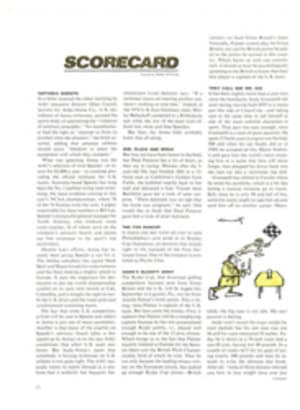
FORBES WAS BOUND TO BOMB, SHOT DOWN BY AN AIRPLANE IF NOTHING ELSE
Publisher-Balloonist Malcolm S. Forbes' Windborne (SI, Dec. 16), the million-dollar aerostatic creation that was to carry him across the Atlantic last January, has finally made it to France. The crossing, alas, was not made at 40,000 feet, wafting through the jet stream as Forbes had planned, but unceremoniously in the belly of a jumbo jet. Forbes' dream of accomplishing a feat that has defied and killed numerous balloonists has been laid to rest, at least for now, with the decision to install Windborne in his ballooning museum in Normandy.
The museum, which opened last month with fanfare and considerably more champagne than launched the ill-fated Windborne, is located on the grounds of Forbes' Chateau de Balleroy, the 50-room castle he bought in 1970 from the surviving member of the family that built it in 1626. Forbes restored much of the interior to its original grandeur before opening the museum to the public. The chateau's magnificent stone work, formal gardens, gilded ceilings, exquisite art collection and proximity (19 miles) to the D-Day beaches in Normandy assure that it will be a popular tourist attraction.
"There has never been a museum devoted entirely to ballooning," Forbes says, "and certainly there could be no better location for one than France where the Montgolfier brothers launched the first free-flight balloon in 1783. The extraordinary part of all this is that at the time I bought the chateau I wasn't even into ballooning." But that changed shortly thereafter. In 1973 Forbes set six world records in the sport and became the first person ever to cross the U.S. in a single balloon, named Chateau de Balleroy. The 65-foot blue-and-gold aerostat is on display in the museum complex Forbes built last year, along with a diverse collection of artifacts, books, prints, films and other balloon memorabilia, much of it on indefinite loan from the French government.
Visitors (the $2 admission includes entry to the chateau and grounds) will see only Windborne's one-ton gondola. The 13 Mylar meteorological-type balloons which were to have carried it aloft have long since settled into the mountains southeast of Los Angeles. When the launching system, which was to have released them at intervals, failed, thus rocketing all the balloons into the air at once with the gondola dragging dangerously out of control behind, the balloons were severed from the gondola by an emergency release. Had they not been, it seems certain that Windborne's occupants, Forbes and scientist Thomas Heinsheimer, would have perished. What had seemed so foolproof on the drawing boards proved in practice to have fatal flaws.
"With all the expertise that went into the airborne part of the flight, nobody had foreseen that the launching system was inadequate," Forbes says. "At first I thought we could make another attempt since the gondola was not structurally damaged and we had extra Mylar for an additional set of balloons. But when we began assembling information on what had actually happened, it cast a whole new light on the project.
"First we heard from people on a TWA flight that they spotted the balloons exploding somewhere around 45,000 to 50,000 feet. Since the balloons were pressurized at 40,000 feet, we assume their accelerated and uncontrolled rise coupled with no weight load were responsible. Unfortunately attempts to recover the remains of the balloons, both by helicopter and horse, failed because of their weight and the terrain in which they came down. We had no choice but to leave them, though we did bring out the riggings. Their condition told us something none of the tests had anticipated. As the balloons rose in their respective clusters, they moved in and out in such a way that their riggings became interwoven as tightly as if they had been crocheted. Each individual rigging was threaded with over a mile of electrical wiring connected to a broad range of sensors and controls. As a result of the weaving action, many of the electrical connections had been severed at their bases. In addition, six of the riggings contained mechanical cutters to eventually release balloons from the gondola for descent. The wiring for these was also severed. Had we by some miracle—and it would have been a miracle—made it to France, when we pulled the switch to descend nothing would have happened. Short of having aircraft literally shoot the balloons down, we would have been up there for good.
"When all the facts were in, we had no choice but to suspend the project. That doesn't mean that it couldn't be resumed again at some future date. Du Pont has developed a fabric, Kevlar, that has five times the strength of steel. The U.S. and French space agencies are both trying to develop a balloon from Kevlar, believing it would be more durable than Mylar at high altitudes. Who knows? Windborne's life-support and communications systems are in working order. In a couple of years it might be possible to hook her up to a single Kevlar balloon strong enough to carry her across the Atlantic.
"In the meantime," Forbes adds, "we have replaced the wall we broke through to get Windborne into the museum with a temporary one—just in case."

